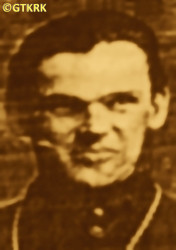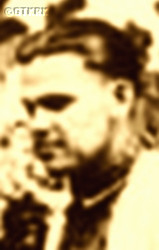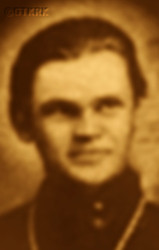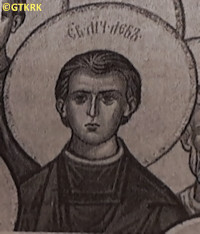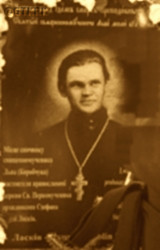Roman Catholic
St Sigismund parish
05-507 Słomczyn
85 Wiślana Str.
Konstancin deanery
Warsaw archdiocese, Poland
full list:
displayClick to display full list

searchClick to search full list by categories
wyświetlKliknij by wyświetlić pełną listę po polsku

szukajKliknij by przeszukać listę wg kategorii po polsku

Martyrology of the clergy — Poland
XX century (1914 – 1989)
personal data
religious status
saint
surname
KOROBCZUK
forename(s)
Leo (pl. Lew)
canonisation date
07.06.2003

Saint Council of the Bishops of the Polish Autocephalous Orthodox Churchmore on
en.wikipedia.org
[access: 2019.12.07]
function
presbiter (i.e. iereus)
creed
Eastern Orthodox Church ORmore on
en.wikipedia.org
[access: 2014.09.21]
diocese / province
Chełm‐Podlachia OR eparchy (Autocephalous Orthodox Church in the Generalgouvernement AOC‐GG)more on
pl.wikipedia.org
[access: 2021.08.20]
date and place
of death
10.03.1944

Łaskówtoday: Mircze gm., Hrubieszów pov., Lublin voiv., Poland
more on
en.wikipedia.org
[access: 2021.08.20]
details of death
After German and Russian invasion of Poland in 09.1939 and the beginning of World War II, after the start of the German occupation, during genocide of Poles known as «Genocidium Atrox», perpetrated by the Ukrainian genocidal OUN/UPA organisations, murdered during an attack by a partisan detachment of the clandestine Home Army AK under the command of Stefan Kwaśniewski and the Peasants' Battalions BCh detachment under the command of Stanislav Basaj, nom‐de‐guerre „Ryś” (part of the Polish Clandestine State) on the Ukrainian village.
In a group of about 20 parishioners was hiding in an underground shelter, from which was taken out and after torture killed along all the others.
Shot several times, his head was cut off and his whole body stabbed with a knife.
The action was carried out when the AK intelligence recognized Łasków as one of the places of concentration of the genocidal Ukrainian OUN/UPA organization. The destruction of the village was supposed to have a deterrent effect on Ukrainians. According to the account of the Polish participant in the attack, a warehouse of real weapons belonging to the OUN/UPA was found in bunkers located in the village. According to various sources, 150‐800 Ukrainians were murdered that day in a few neighbouring villages.
cause of death
mass murder
perpetrators
Poles
sites and events
«Genocidium Atrox»Click to display the description, GeneralgouvernementClick to display the description, Ribbentrop‐MolotovClick to display the description
date and place
of birth
09.08.1919

(f. Yaroslav Governorate territory)existing till 1929
today: Russia
more on
en.wikipedia.org
[access: 2021.08.20]
parents
KOROBCZUK Gabriel
🞲 ?, ? — 🕆 ?, ?

🞲 ?, ? — 🕆 ?, ?
presbyter (holy orders)
ordination
11.10.1942

positions held
02.07.1943 – 1944
parish priest — Łaskówtoday: Mircze gm., Hrubieszów pov., Lublin voiv., Poland
more on
en.wikipedia.org
[access: 2021.08.20] ⋄ St Stephen OR parish — local Orthodox St Stephen's church was supposed to be destroyed around 1939, during a vindication operation of Uniate churches (looted by the Orthodox Church during the Russian partition)
from 02.12.1942
parish priest — Mirczetoday: Mircze gm., Hrubieszów pov., Lublin voiv., Poland
more on
en.wikipedia.org
[access: 2021.09.29] ⋄ St Cosma and St Damian the Martyrs OR parish ⋄ Kryłówtoday: Mircze gm., Hrubieszów pov., Lublin voiv., Poland
more on
en.wikipedia.org
[access: 2024.03.15] OR deanery — the church, after the German occupation began in 10.1939, robbed from Catholics and handed to the Orthodox Church
c. 1942
priest — Chełmtoday: Chełm city pov., Lublin voiv., Poland
more on
en.wikipedia.org
[access: 2021.08.20] ⋄ St John the Evangelist OR cathedral church — employee of the offices of the Chełm–Podlachia Eparchy of the Autocephalous Orthodox Church in the Generalgouvernement AOC‐GG
11.10.1942
presbiter (Eng. priest, i.e. iereus) — Autocephalous Orthodox Church in the Generalgouvernement AOC‐GG — priesthood cheirotonia, i.e. ordination, on 19.04.1942 preceded by deacon cheirotonia
c. 1939 – 1942
psalmist — Werbkowicetoday: Werbkowice gm., Hrubieszów pov., Lublin voiv., Poland
more on
en.wikipedia.org
[access: 2024.01.26] ⋄ St Michael the Archangel OR parish — c. 1940, the local church was forcefully taken over — with the help of the German occupier — by the Orthodox Church (originally it was a Uniate church, during the partition period robbed by the Russians and handed over to the Orthodox Church, after 1918 taken back by the Catholic Church)
1936 – 1939
student — Jabłecznatoday: Sławatycze gm., Biała Podlaska pov., Lublin voiv., Poland
more on
en.wikipedia.org
[access: 2021.12.18] ⋄ School of Conductors and Psalmists ⋄ St Onuphrius OR monastery (stavropegial)
married — two children
others related
in death
BAZYLUKClick to display biography James (monk Ignatius), HOLCClick to display biography Nicholas, MARTYSZClick to display biography Basil, OHRYZKOClick to display biography Peter, PERADZEClick to display biography Gregory (Fr Gregory), SZWAJKOClick to display biography Paul, ZACHARCZUKClick to display biography Sergius
sites and events
descriptions
«Genocidium Atrox»: In 1939‐1947, especially in 1943‐1944, independent Ukrainian units, mainly belonging to genocidal Ukrainian organizations OUN (political arm) and UPA (military arm), supported by local Ukrainian population, murdered — often in extremely brutal way — in Volyn and surrounding regions of pre‐war Poland, from 130,000 to 180,000 Poles, all civilians: men, women, children, old and young. Polish‐Ukrainian conflict that openly emerged during and after World War I (in particular resulting in Polish‐Ukrainian war of 1918‐1919), that survived and even deepened later when western Ukraine became a part Poland, exploded again after the outbreak of the World War II in 09.1939. During Russian occupation of 1939‐1941, when hundreds of thousands of Poles were deported into central Russia, when tens of thousands were murdered (during so‐called Katyń massacres, among others), this open conflict had a limited character, helped by the fact that at that time Ukrainians, Ukrainian nationalists in particular, were also persecuted by the Russians. The worst came after German‐Russian war started on 22.06.1941 and German occupation resulted. Initially Ukrainians supported Germans (Ukrainian police was initiated, Ukrainians co—participated in extermination of the Jews and were joining army units fighting alongside Germans). Later when German ambivalent position towards Ukraine became apparent Ukrainians started acting independently. And in 1943 one of the units of aforementioned Ukrainian OUN/UPA organization, in Volyn, started and perpetrated a genocide of Polish population of this region. In mere few weeks OUN/UPA murdered, with Germans passively watching on the sidelines, more than 40,000 Poles. This strategy was consequently approved and adopted by all OUN/UPA organisations and similar genocides took place in Eastern Lesser Poland (part of Ukraine) where more than 20,000 Poles were slaughtered, meeting however with growing resistance from Polish population. Further west, in Chełm, Rzeszów, etc. regions this genocide turned into an extremely bloody conflict. In general genocide, perpetrated by Ukrainian nationalists, partly collaborating with German occupants, on vulnerable Polish population took part in hundreds of villages and small towns, where virtually all Polish inhabitants were wiped out. More than 200 priests, religious and nuns perished in this holocaust — known as «Genocidium Atrox» (Eng. „savage genocide”) The nature and purpose of genocide is perhaps best reflected in the song sung by the murderers: „We will slaughter the Poles, we will cut down the Jews, we must conquer the great Ukraine” (ukr. „Поляків виріжем, Євреїв видусим, велику Україну здобути мусим”). This holocaust and conflict ended up in total elimination of Polish population and Polish culture from Ukraine, in enforced deportations in 1944‐1945 of remaining Poles from Ukraine and some Ukrainians into Ukraine proper, and finally in deportation of Ukrainians from East‐South to the Western parts of Polish republic prl by Commie‐Nazi Russian controlled Polish security forces („Vistula Action”). (more on: www.swzygmunt.knc.plClick to attempt to display webpage
[access: 2021.06.20])
Generalgouvernement: After the Polish defeat in the 09.1939 campaign, which was the result of the Ribbentrop‐Molotov Pact and constituted the first stage of World War II, and the beginning of German occupation in part of Poland (in the other, eastern part of Poland, the Russian occupation began), the Germans divided the occupied Polish territory into five main regions. In two of them new German provinces were created, two other were incorporated into other provinces. However, the fifth part was treated separately, and in a political sense it was supposed to recreate the German idea from 1915 (during World War I, after the defeat of the Russians in the Battle of Gorlice in 05.1915) of creating a Polish enclave within Germany. Illegal in the sense of international law, i.e. Hague Convention, and public law, managed by the Germans according to separate laws — especially established for the Polish Germ. Untermenschen (Eng. subhumans) — till the Russian offensive in 1945 it constituted part of the Germ. Großdeutschland (Eng. Greater Germany). Till 31.07.1940 formally called Germ. Generalgouvernement für die besetzten polnischen Gebiete (Eng. General Government for the occupied Polish lands) — later simply Germ. Generalgouvernement (Eng. General Governorate), as in the years 1915‐1918. From 07.1941, i.e. after the German attack on 22.06.1941 against the erstwhile ally, the Russians, it also included the Galicia district, i.e. the Polish pre‐war south‐eastern voivodeships. A special criminal law was enacted and applied to Poles and Jews, allowing for the arbitrary administration of the death penalty regardless of the age of the „perpetrator”, and sanctioning the use of collective responsibility. After the end of the military conflict of the World War UU, the government of the Germ. Generalgouvernement was recognized as a criminal organization, and its leader, governor Hans Frank, guilty of war crimes and crimes against humanity and executed. (more on: en.wikipedia.orgClick to attempt to display webpage
[access: 2024.12.13])
Ribbentrop‐Molotov: Genocidal Russian‐German alliance pact between Russian leader Joseph Stalin and German leader Adolf Hitler signed on 23.08.1939 in Moscow by respective foreign ministers, Mr. Vyacheslav Molotov for Russia and Joachim von Ribbentrop for Germany. The pact sanctioned and was the direct cause of joint Russian and German invasion of Poland and the outbreak of the World War II in 09.1939. In a political sense, the pact was an attempt to restore the status quo ante before 1914, with one exception, namely the „commercial” exchange of the so‐called „Kingdom of Poland”, which in 1914 was part of the Russian Empire, fore Eastern Galicia (today's western Ukraine), in 1914 belonging to the Austro‐Hungarian Empire. Galicia, including Lviv, was to be taken over by the Russians, the „Kingdom of Poland” — under the name of the General Governorate — Germany. The resultant „war was one of the greatest calamities and dramas of humanity in history, for two atheistic and anti‐Christian ideologies — national and international socialism — rejected God and His fifth Decalogue commandment: Thou shall not kill!” (Abp Stanislav Gądecki, 01.09.2019). The decisions taken — backed up by the betrayal of the formal allies of Poland, France and Germany, which on 12.09.1939, at a joint conference in Abbeville, decided not to provide aid to attacked Poland and not to take military action against Germany (a clear breach of treaty obligations with Poland) — were on 28.09.1939 slightly altered and made more precise when a treaty on „German‐Russian boundaries and friendship” was agreed by the same murderous signatories. One of its findings was establishment of spheres of influence in Central and Eastern Europe and in consequence IV partition of Poland. In one of its secret annexes agreed, that: „the Signatories will not tolerate on its respective territories any Polish propaganda that affects the territory of the other Side. On their respective territories they will suppress all such propaganda and inform each other of the measures taken to accomplish it”. The agreements resulted in a series of meeting between two genocidal organization representing both sides — German Gestapo and Russian NKVD when coordination of efforts to exterminate Polish intelligentsia and Polish leading classes (in Germany called «Intelligenzaktion», in Russia took the form of Katyń massacres) where discussed. Resulted in deaths of hundreds of thousands of Polish intelligentsia, including thousands of priests presented here, and tens of millions of ordinary people,. The results of this Russian‐German pact lasted till 1989 and are still in evidence even today. (more on: en.wikipedia.orgClick to attempt to display webpage
[access: 2015.09.30])
sources
personal:
prasa.wiara.plClick to attempt to display webpage
[access: 2013.05.19], pl.wikipedia.orgClick to attempt to display webpage
[access: 2013.05.19], www.impantokratoros.grClick to attempt to display webpage
[access: 2013.05.19], drevo-info.ruClick to attempt to display webpage
[access: 2024.01.26]
bibliographical:
„Hierachy, clergy and employees of the Orthodox Church in the 19th‐21st centuries within the borders of the Second Polish Republic and post–war Poland”, Fr Gregory Sosna, M. Antonine Troc-Sosna, Warsaw–Bielsk Podlaski 2017
original images:
www.przegladprawoslawny.plClick to attempt to display webpage
[access: 2013.08.10], www.impantokratoros.grClick to attempt to display webpage
[access: 2013.05.19], www.impantokratoros.grClick to attempt to display webpage
[access: 2013.05.19]
LETTER to CUSTODIAN/ADMINISTRATOR
If you have an Email client on your communicator/computer — such as Mozilla Thunderbird, Windows Mail or Microsoft Outlook, described at WikipediaPatrz:
en.wikipedia.org, among others — try the link below, please:
LETTER to CUSTODIAN/ADMINISTRATORClick and try to call your own Email client
If however you do not run such a client or the above link is not active please send an email to the Custodian/Administrator using your account — in your customary email/correspondence engine — at the following address:

giving the following as the subject:
MARTYROLOGY: KOROBCZUK Leo
To return to the biography press below:
 Click to return to biography
Click to return to biography








